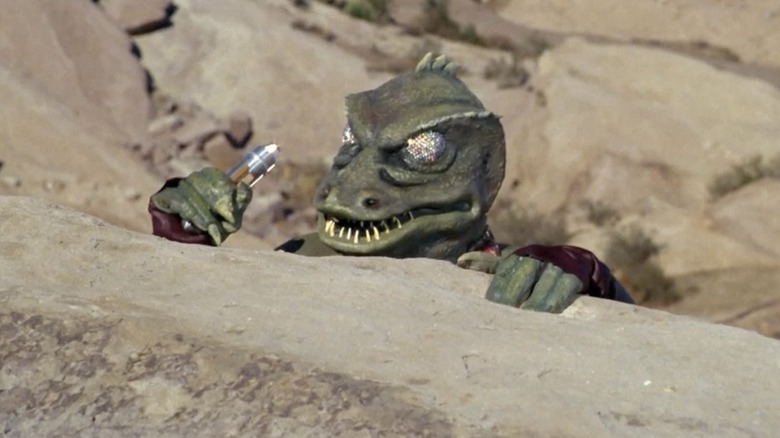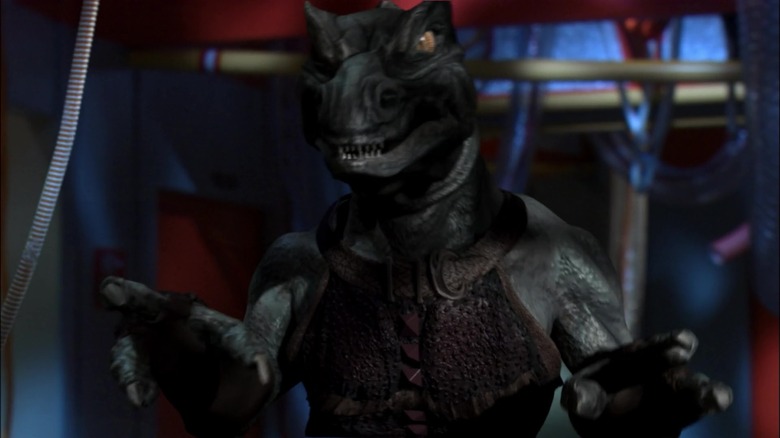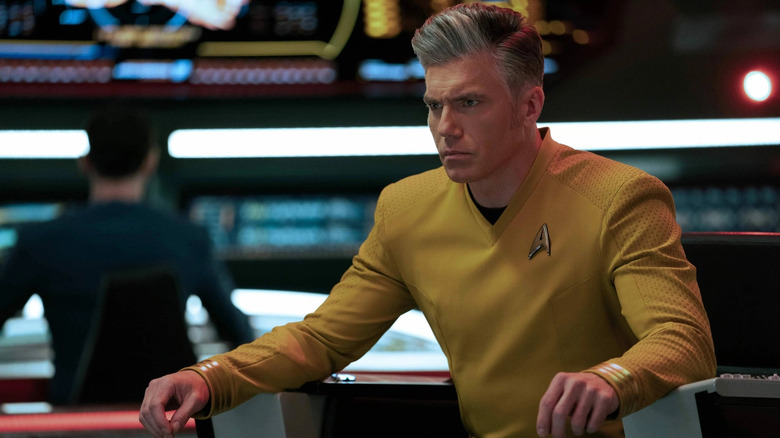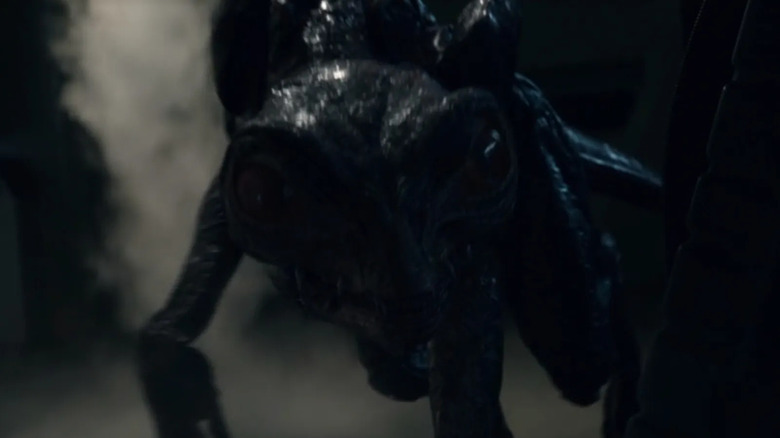The Gorn Gave Star Trek: Strange New Worlds A Tricky Problem To Solve
One of the more indelible images from "Star Trek" is that of the Gorn, the angry reptilian alien captain that appeared in the second season episode "Arena" (January 19, 1967). In that episode Kirk (William Shatner), forced by a judgmental godlike Metron (Carole Shelyn), awkwardly fought the Gorn captain (voice of Ted Cassidy) in a fashion approaching the somnambulistic. The awkward, unmoving Gorn Halloween mask has burned itself into cultural memory, becoming something of a Jungian archetype (at least as it relates to low-budget sci-fi TV). To this day, Trekkies will make pilgrimages to Vasquez Rocks in California where the Kirk/Gorn battle was shot.
While the Gorn fight in "Arena" hovers comfortably in the realm of camp, the Gorn themselves have — thanks to the passion of Trekkies — passed into canon. The mask seems to have been an issue, however, as Trek makeup artists throughout the 1990s (arguably the franchise's heyday) didn't attempt to include any more Gorn on the various shows, perhaps unsure as to how to make them look more realistic. The Gorn wouldn't be seen again until the "Enterprise" episode "In a Mirror, Darkly Part II" (April 29, 2005), and the reptile would be realized with CGI that's arguably even more awkward than the original mask.
In the fourth episode of "Star Trek: Strange New Worlds," called "Memento Mori" (May 26, 2022), the Gorn serve as a threatening antagonist, this time attacking the Enterprise from afar, strafing the Starfleet vessel without showing their faces. Since "Strange New Worlds" takes place prior to the original "Star Trek," this stood in contrast with the previously established canon that Kirk was the first to encounter them. In an interview with Inverse, Davy Perez, the episode's co-screenwriter, takined about that canon.
Dialogue from 'Arena'
"Arena" made it pretty clear that the Gorn hadn't been seen by humans before. Kirk even provides a voiceover explaining that, even when trying to remain open-minded, he struggled with ophidiophobia. He was not prepared to deal with any reptiles, much less this species that no one had seen before.
In wanting to include the Gorn on "Strange New Worlds," Perez says he and his co-screenwriter Beau DeMayo had to come up with a story that would honor Kirk's statements about no one having seen a Gorn before, but still include them as a threat in a pre-Kirk world. In "Memento Mori," the character of La'an Noonien-Singh (Christina Chong) explains that she, as a young colonist, once witnessed the violence of the Gorn, and was incredibly wary about their approach. As her experiences were not necessarily recorded, the Gorn handily remained in the realm of hearsay and urban myth. Says Perez:
"We discussed this quite a bit, how to honor the idea that people either haven't seen [the Gorn] and in some cases might not even believe they exist. There is a lot we still don't know about the Gorn. What was fun for me was using parts from 'Arena' we do know to inform some of their behavior ... Our goal is never to undo people's experience with the original series. But if we can manage it, perhaps to give us an interesting perspective to consider that lines up with the original stories."
Expand the myth, while coloring inside the lines. This is Trek storytelling ethos as its most practical.
The submarine episodes
Perez knew the timeline of events going in: Kirk didn't first see a Gorn until 2267, and "Strange New Worlds" takes place in 2259. Perez's solution was simple: No one sees the Gorn. They only hear the stories and do battle with their ship. If no one sees a Gorn, then Kirk can still be the first to lay eyes on them eight years hence. The timeline is preserved.
"I think there were some early ideas floating around where we might have caught a glimpse of one. But there was always the idea that we should hear about them and begin to dread the Gorn without ever actually seeing them. Once we decided not to see them at all, the episode sprang to life."
Once the episode sprang to life, Perez immediately started to zero in on structural concerns. "Memento Mori" was not a repeat of "Arena," but bore more resemblances to "Balance of Terror" or "Star Trek II: The Wrath of Khan," in that it was a submarine-style battle episode wherein two ships, unable to see one another and not communicating, make quick aggressive passes, each suffering damage along the way. Although Perez doesn't say which titles or what era of submarine combat he studied, such research was a vital part of the episode. Once the Gorn had been hidden from view, the real scaffolding for "Memento Mori" appeared.
"I did a deep dive on submarine movies when I was researching this episode. I wanted to emulate that same feeling as 'Balance of Terror.' We put the focus on our crew working together and dealing with their respective problems all over the ship."
Baby Gorn
To remind the reader, issues of canon remain of particular importance to Trekkies, and it was arguably Trekkies (along with Whovians) who largely invented the notion in the 1960s. The idea that a sci-fi show would have a broader unexplored universe outside of what was dramatized on the show — and indeed that the central cast would be having adventures the audience wouldn't see — was popularized with the geek cults of Trekkies and Whovians.
The Gorn would return — as feral monster babies — in "All Those Who Wander," the ninth episode of "Strange New Worlds." The episode was a straight-up horror story wherein an away team explored a downed vessel that had been seeded with Gorn eggs. Gorn babies, like the creatures from Ridley Scott's "Alien," incubate inside other being's bodies, and burst out through a person's abdomen when they have grown large enough. Because baby Gorn are so unlike adult Gorn — they're quick-moving, quadrupedal dinosaur predators — the notion that no one had seen a Gorn until Kirk could still ... technically ... remain intact.
Whether one feels that canon is confining or freeing, it was polite of Perez and other "Strange New Worlds" writers to familiarize themselves — and respect — the scriptures as they had been laid out over 50 years ago. The deliberate references and connections can only make this show stronger.
The second season of "Strange New Worlds" is set to debut in 2023.



